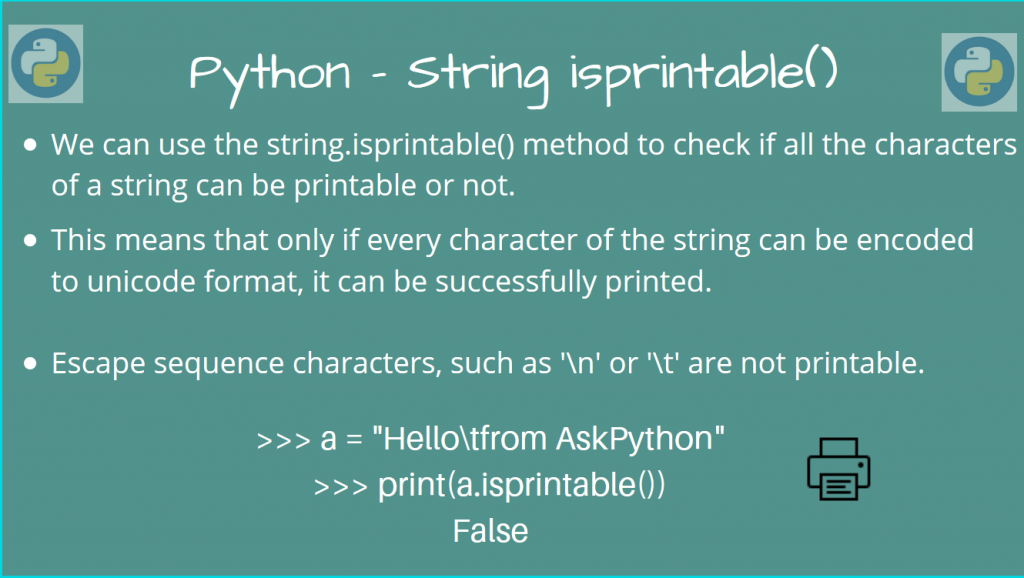In this article, we will explore the Python String isprintable() function, its purpose, and its applications. This built-in function is useful for checking if a given string contains only printable characters, and it returns a boolean value accordingly. Understanding how to use this function is essential for handling strings containing non-printable characters efficiently in your Python projects.
What is Python string isprintable()?
The Python String isprintable() method is a valuable tool in determining if a given string contains only printable characters or not. This built-in function checks if all characters in the string can be successfully decoded to a Unicode character without generating any errors.
By returning a boolean value (True for printable strings and False for non-printable ones), this method allows developers to handle strings with non-printable characters efficiently.
Characteristics of Python String isprintable() Method
Certain characters in Python strings cannot be directly printed to the console (file). They are classified as “Other” or “Separator” in the Unicode Character Database.
Note, the ASCII space character (0x20) is an exception to this, as it can obviously be printed.
Another way of thinking about printable strings is that it can be successfully decoded to a Unicode character. Any non-printable string will throw an error in that regard.
It is roughly equivalent to the following method:
def isprintable(s, codec='utf8'):
try: s.decode(codec)
except UnicodeDecodeError: return False
else: return True
If we can get the decoded string in utf-8 format, then it can be printed. Otherwise, we simply return False.
So let’s check how we can use this function, using some examples.
To use this function, we must call Python string isprintable() method on a string object.
ret = string.isprintable()
ret is a Boolean, which is True, if the string can be printed. Otherwise, it is False.
>>> a = "Hello from AskPython"
>>> print(a.isprintable())
True
Here, all the characters in our string are printable, so it returns True.
An empty string is also printable.
>>> b = ""
>>> print(b.isprintable())
True
We cannot print escaped characters like \n or \t, so if our string has any of the escape sequences, isprintable() will return False.
>>> c = "Hello from AskPython\n"
>>> print(c.isprintable())
False
>>> d = "Hello\tfrom\tAskPython"
>>> print(d.isprintable())
False
There are some characters (like \u0066 -> f), which can be printed, but others (like \u0009 -> \t) cannot.
Basically, they must map to a valid unicode character.
>>> e = "Hello \u0066rom AskPython"
>>> print(e.isprintable())
True
>>> print(e)
Hello from AskPython
>>> f = "Hello \u0066rom\u0009AskPython"
>>> print(f.isprintable())
False
>>> print(f)
Hello from AskPython
To conclude with the working of the isprintable() method, let’s look at finding out all the non-printable characters in our unicode database.
Finding Non-Printable Unicode Characters
The total number of unicode characters is 2^16, so we will make a loop which goes through every character, and checks if it can be printed or not.
count = 0
for ascii_val in range(2 ** 16):
ch = chr(ascii_val)
if not ch.isprintable():
count += 1
print(f"Total Number of Non-Printable Unicode Characters = {count}")
Output
Total Number of Non-Printable Unicode Characters = 10249
Conclusion
In this article, we learned how we could use the Python String isprintable() method to check if the characters of a string can be printed or not. We also discussed how it can be used to check if a string is printable or not, and we also learned how to identify non-printable characters in the Unicode database.
With this knowledge, you can now better handle strings containing non-printable characters in your Python projects. How do you think this method can be helpful in processing and validating user input in your applications?
References
- StackOverflow Question on String isprintable()
